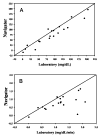The accuracy of the FreeStyle Navigator continuous glucose monitoring system in children with type 1 diabetes
- PMID: 17192334
- PMCID: PMC1764630
- DOI: 10.2337/dc06-1407
The accuracy of the FreeStyle Navigator continuous glucose monitoring system in children with type 1 diabetes
Abstract
Objective: To evaluate the accuracy and precision of the FreeStyle Navigator continuous glucose monitoring system in children with type 1 diabetes.
Research design and methods: In 30 children with type 1 diabetes (mean age 11.2 +/- 4.1 years), the Navigator glucose values were compared with reference serum glucose values of blood samples obtained in an inpatient clinical research center and measured in a central laboratory using a hexokinase enzymatic method and in an outpatient setting with a FreeStyle meter. Median absolute difference (AD) and median relative absolute difference (RAD) were computed for sensor-reference and sensor-sensor pairs.
Results: The median AD and RAD were 17 mg/dl and 12%, respectively, for 1,811 inpatient sensor-reference pairs and 20 mg/dl and 14%, respectively, for 8,639 outpatient pairs. The median RAD between two simultaneous Navigator measurements (n = 1,971) was 13%. Ninety-one percent of sensors in the inpatient setting and 81% of sensors in the outpatient setting had a median RAD < or = 20%.
Conclusions: The Navigator's accuracy does not yet approach the accuracy of current-generation home glucose meters, but it is sufficient to believe that the device has the potential to be an important adjunct to treatment of youth with type 1 diabetes.
Figures
References
-
- Van den Berghe G, Wilmer A, Hermans G, Meersseman W, Wouters PJ, Milants I, Van Wijngaerden E, Bobbaers H, Bouillon R. Intensive Insulin Therapy in the Medical ICU. N Engl J Med. 2006;354:449–461. - PubMed
-
- Van den Berghe G, Wouters P, Weekers F, Verwaest C, Bruyninckx F, Schetz M, Vlasselaers D, Ferdinande P, Lauwers P, Bouillon R. Intensive Insulin Therapy in Critically Ill Patients. N Engl J Med. 2001;345:1359–1367. - PubMed
-
- Passey RB, Gillum RL, Fuller JB, Urry FM, Giles ML. Evaluation and comparison of 10 glucose methods and the reference method recommended in the proposed product class standard (1974) Clin Chem. 1977;23:131–139. - PubMed
Publication types
MeSH terms
Substances
Grants and funding
- RR 06022/RR/NCRR NIH HHS/United States
- U10 HD041906/HD/NICHD NIH HHS/United States
- U10 HD041918/HD/NICHD NIH HHS/United States
- M01 RR000069/RR/NCRR NIH HHS/United States
- HD041918-01/HD/NICHD NIH HHS/United States
- HD041908-01/HD/NICHD NIH HHS/United States
- M01 RR000059/RR/NCRR NIH HHS/United States
- U10 HD041919/HD/NICHD NIH HHS/United States
- U01 HD041890/HD/NICHD NIH HHS/United States
- U10 HD041915/HD/NICHD NIH HHS/United States
- U10 HD041908/HD/NICHD NIH HHS/United States
- M01 RR00069/RR/NCRR NIH HHS/United States
- HD041915-01/HD/NICHD NIH HHS/United States
- HD041919-01/HD/NICHD NIH HHS/United States
- RR00059/RR/NCRR NIH HHS/United States
- U10 HD041890/HD/NICHD NIH HHS/United States
- HD041890/HD/NICHD NIH HHS/United States
- HD041906-01/HD/NICHD NIH HHS/United States
- M01 RR000070/RR/NCRR NIH HHS/United States
- RR00070-41/RR/NCRR NIH HHS/United States
- M01 RR006022/RR/NCRR NIH HHS/United States
LinkOut - more resources
Full Text Sources
Other Literature Sources
Medical


